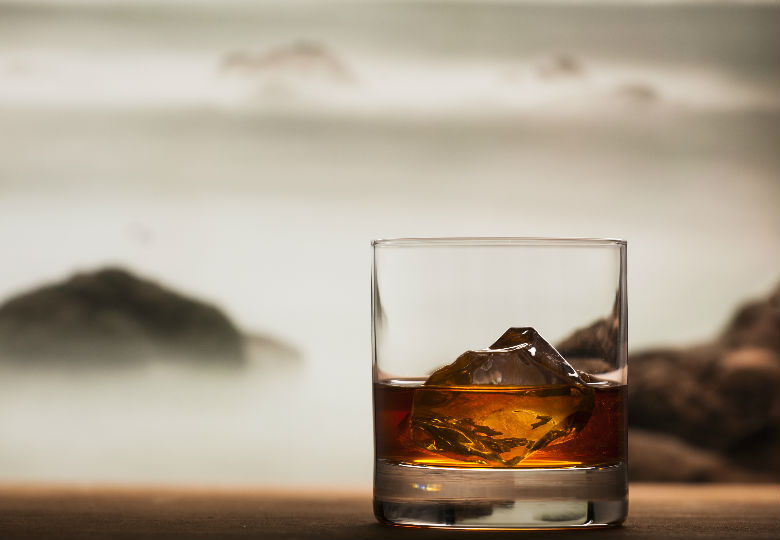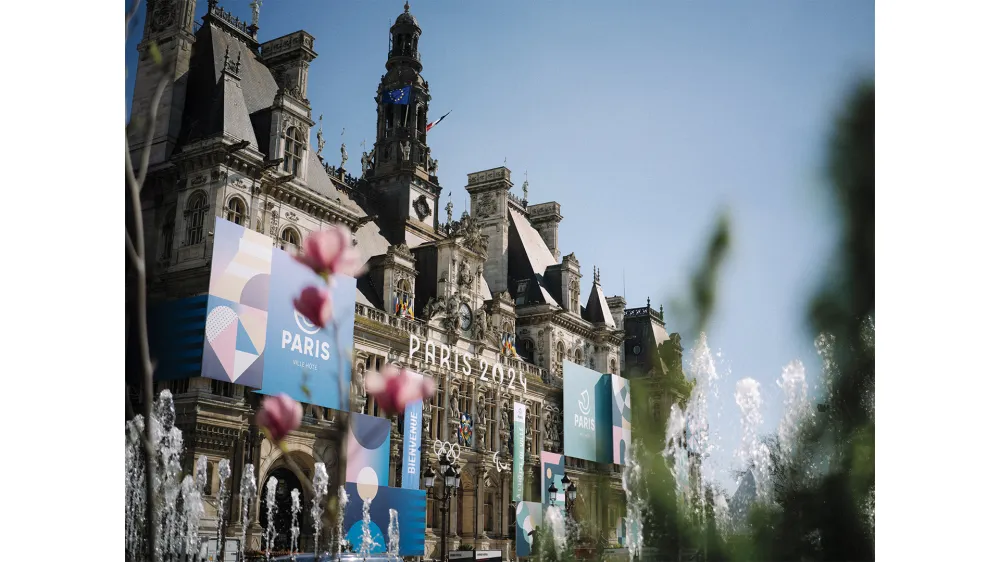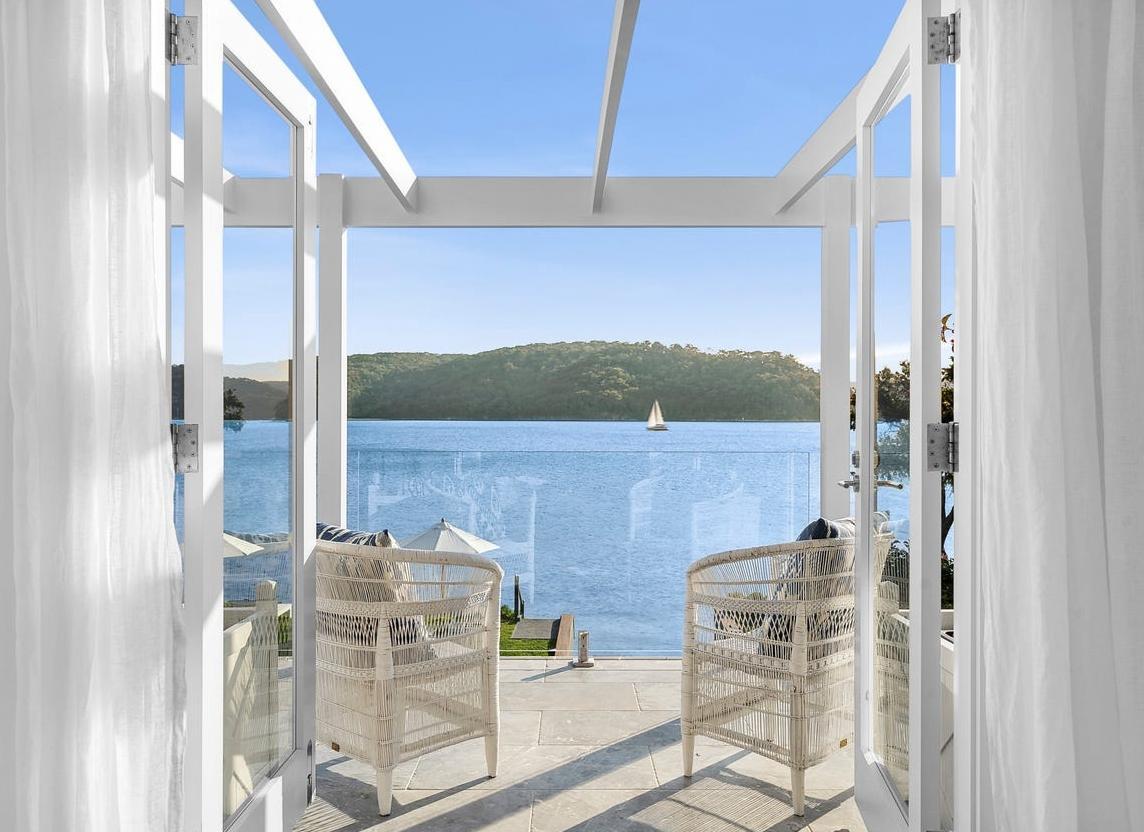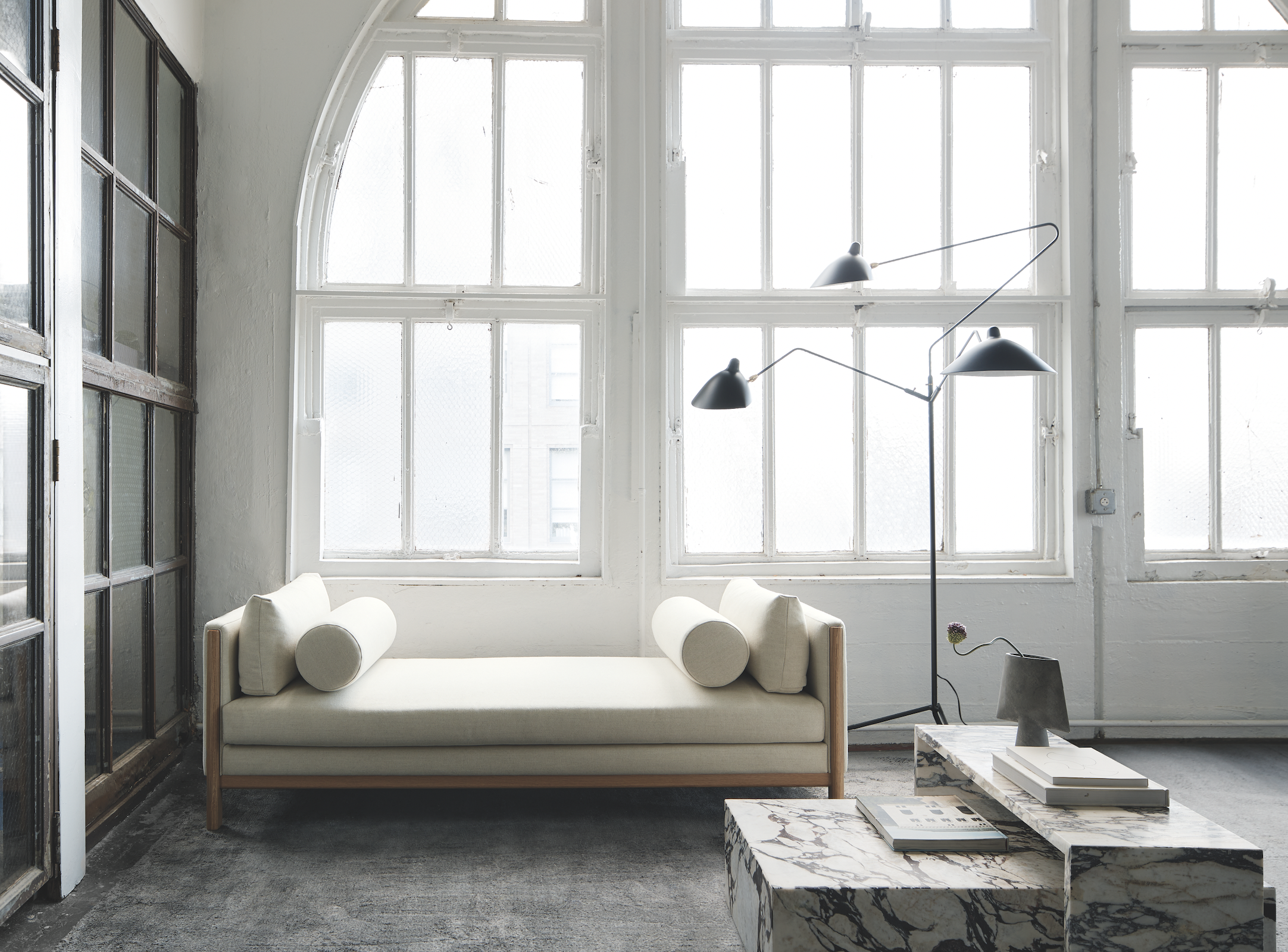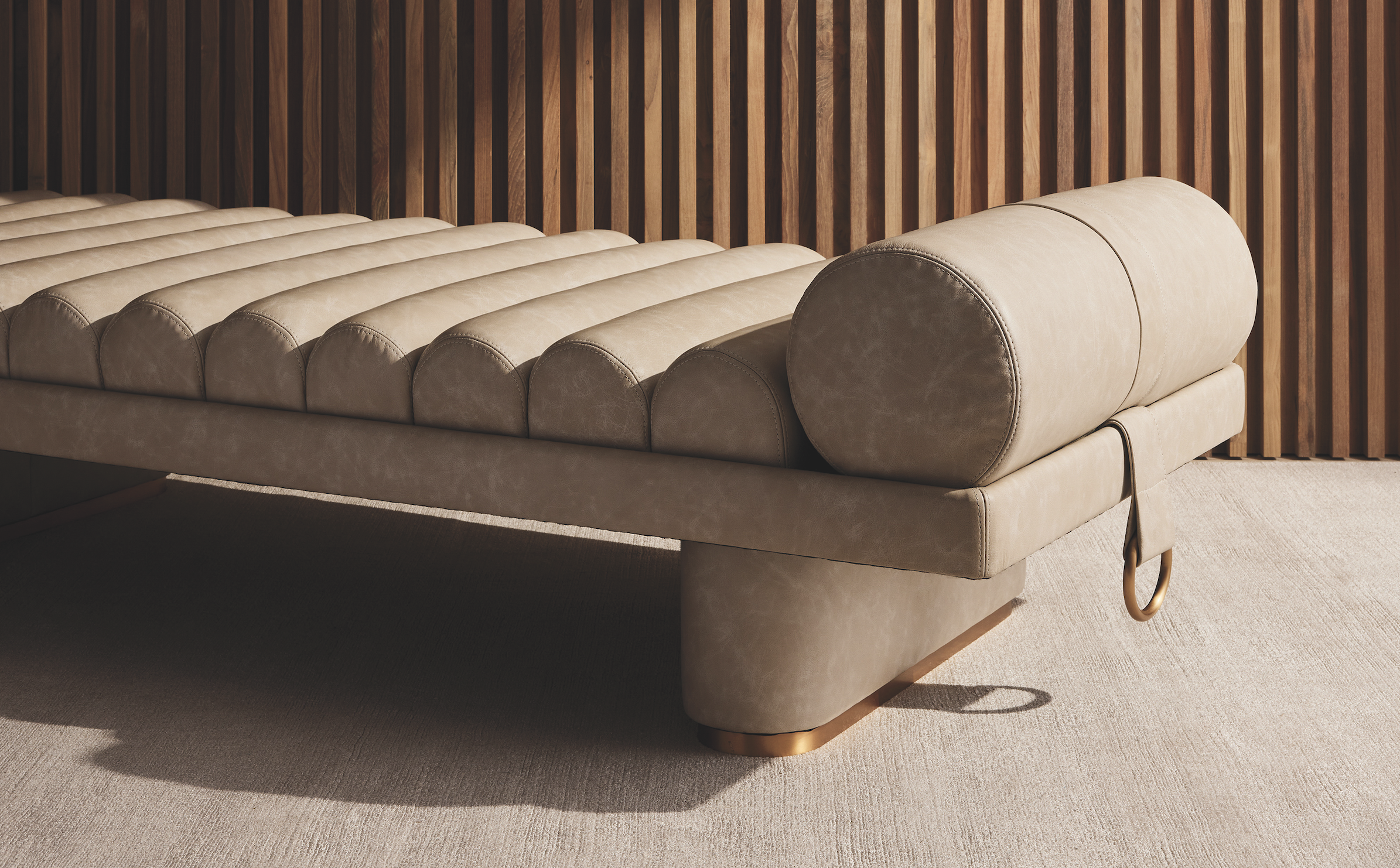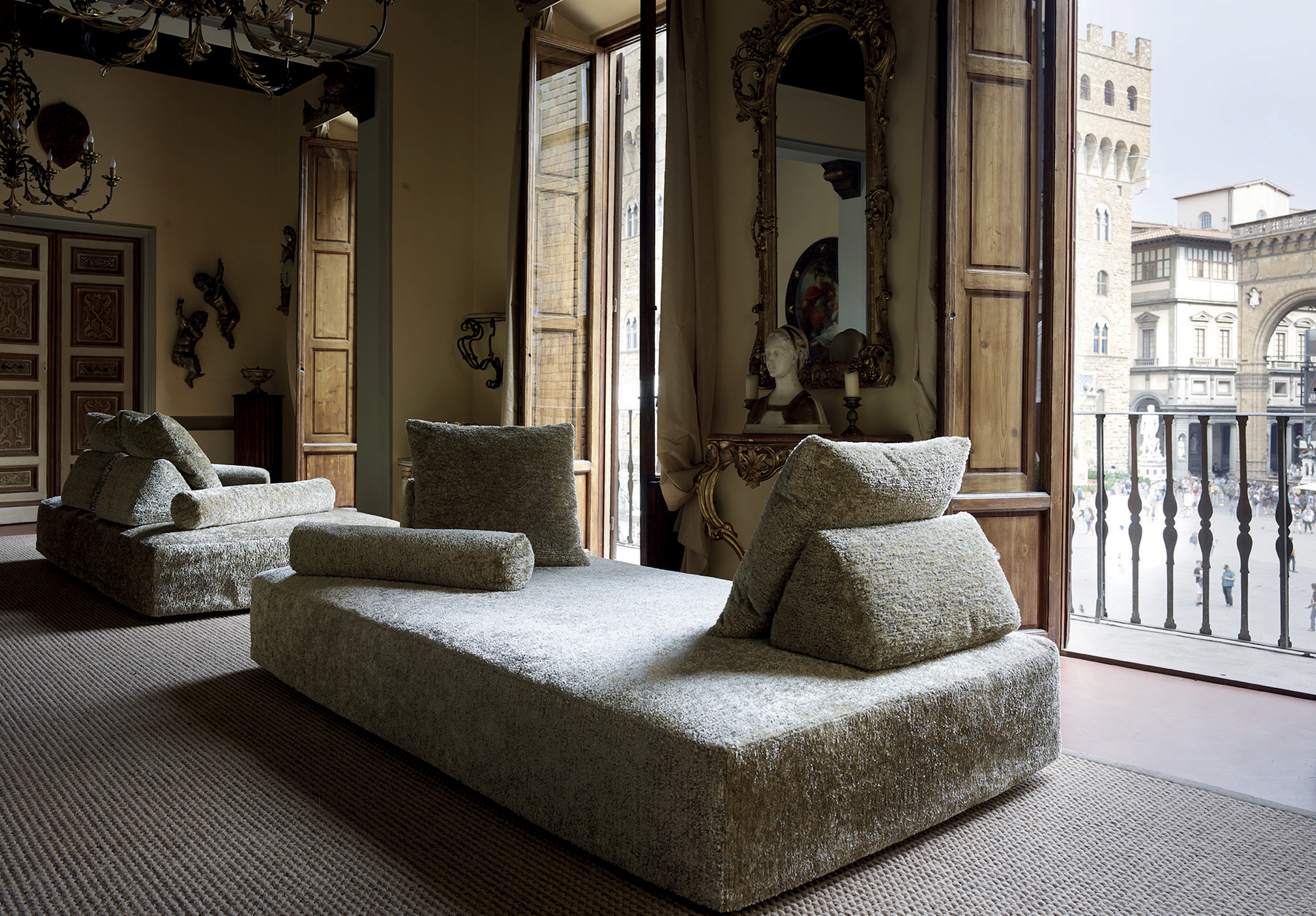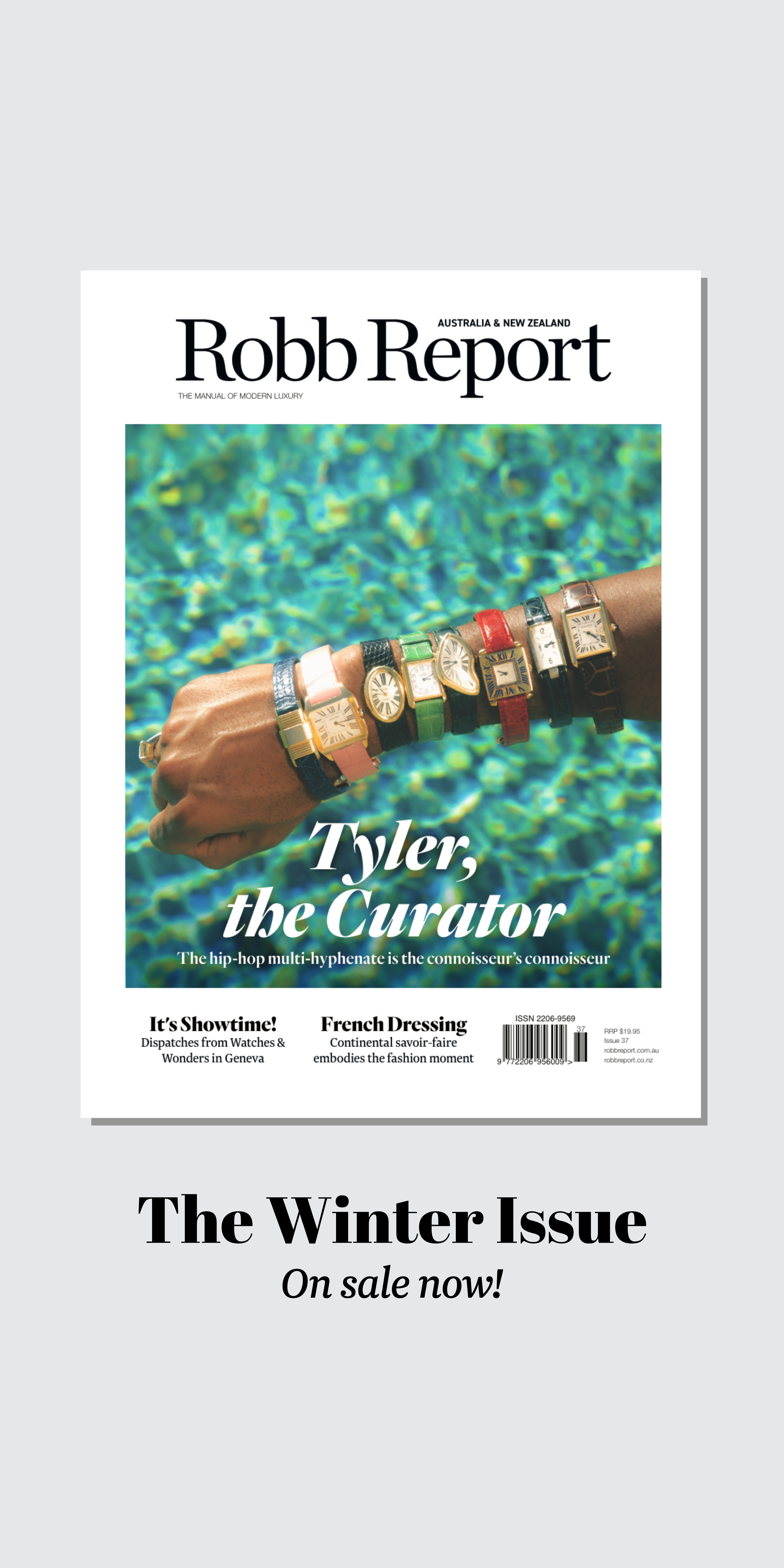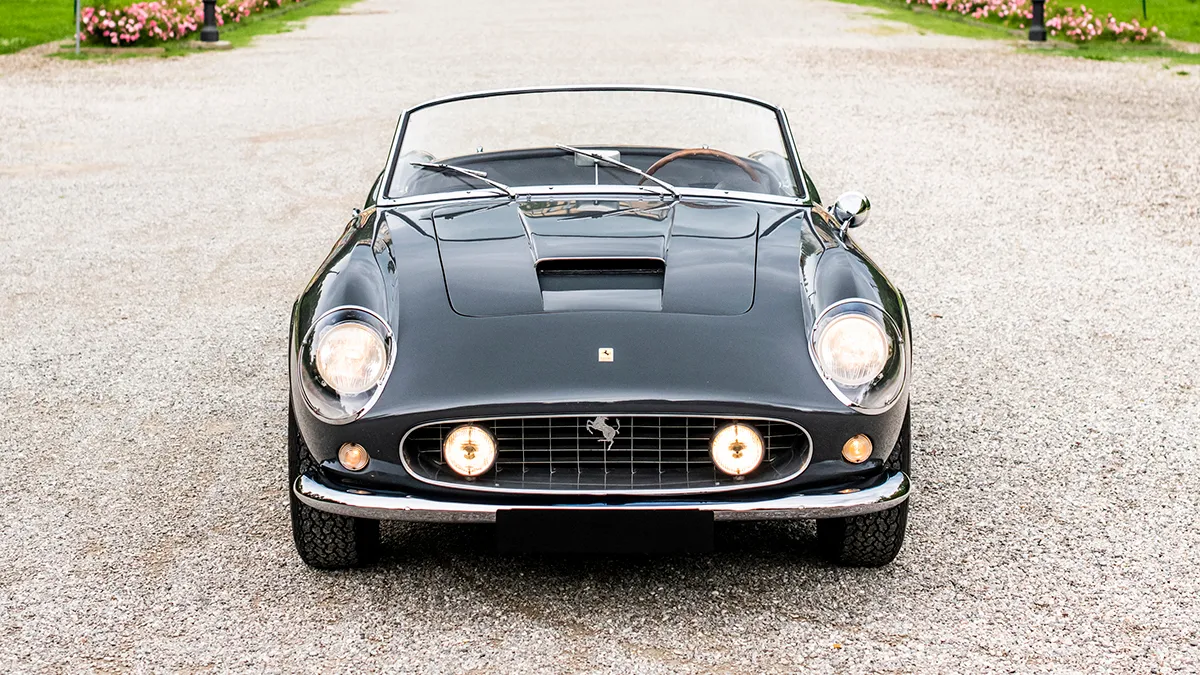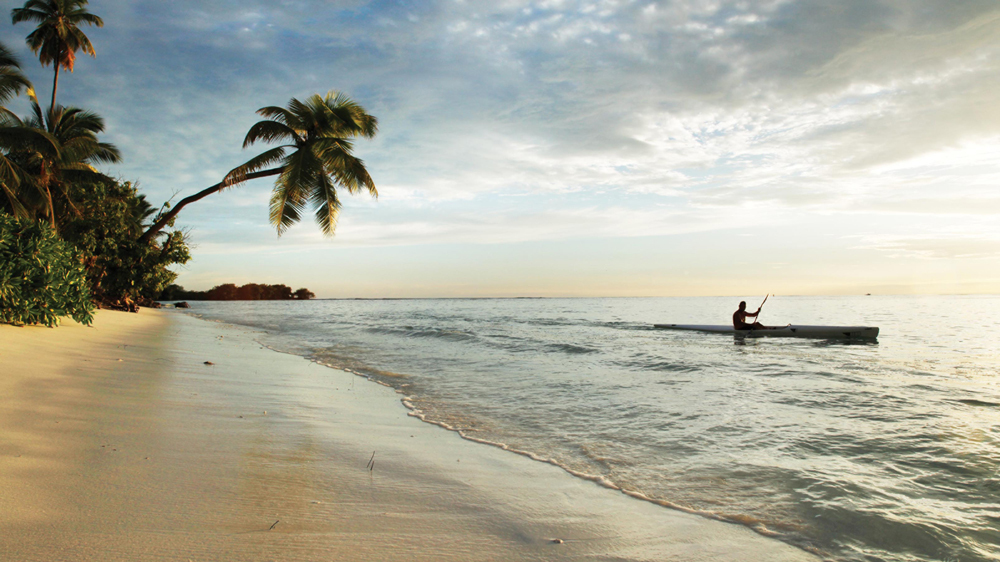
13 Secret Beaches for a Clandestine Getaway
You won’t have to share the sand at these hidden paradises around the world.
Related articles
Beaches, like travellers, come in all styles. There are the sleek and sophisticated ones, the powdery-soft stretches that make all the “most beautiful” lists and star in countless Instagram posts. There are the party ones, home to lively day clubs and DJ-fueled parties, and the boho-chic ones that chill out with bonfires and sing-a-longs. Exotic ones in far-flung locations are vibrant with colour and culture, while rocky ones may seem prickly at first, but end up revealing their own treasures.
But our favourite beaches are the ones you have to work for—the little-known stretches of sand around the world that require a real effort to find. Here, we spotlight 13 such spots—beaches that are local secrets, hidden away, and totally private. They aren’t just exclusive or reserved for a lucky few, but real discoveries, like the beach in Australia that requires a two-day return hike, or another one in Bermuda that only exists for a few hours of the day at low tide. From Mykonos to Mozambique, these 13 beaches are so special, you might not want to share (and good thing, you won’t have to).
Mopion Island, Saint Vincent and the Grenadines
While the “secret” of the Grenadines appears to have already gotten out, there are still some less-discovered—and off-the-beaten-path—places hidden along this Eastern Caribbean gem. Tiny Mopion Island, or as locals call it, “Sandy Island,” is the perfect spot for a true castaway experience, as there’s nothing there but a thatch-roofed palapa and two cushy loungers. The islet is ringed by coral (making it a great launch pad for snorkelling and diving), so you can only access it via a narrow channel—meaning you’ll have to ride in on a dingy from your private boat.
Where to Stay: Less than two kilometres from Mopion, the private island resort of Petit St. Vincent is the closest place to stay. The property offers complimentary half-days on the isolated beach, complete with a breakfast or lunch picnic and a walkie-talkie to radio the staff when you’re ready to be “rescued.”

Mopion Island comes with nothing but a whole lot of sand and a palapa for two.
Photo: Petit St. Vincent
North Point and South Point Beaches, Benguerra Island, Mozambique
Gorgeous white-sand beaches abound in Mozambique’s Bazaruto Archipelago, and many of them are only accessible via some private and exclusive way. Some of our favourite beaches in the region, though, are right on Benguerra—mainly because you’re pretty much guaranteed to never see another person while you’re there. Reachable via helicopter from mainland Mozambique, and set just south of the larger island of Bazaruto, Benguerra is only home to a few resorts—so when one hotel is planning on setting up a “castaway” picnic for their guests, it coordinates with the others to make sure no one else will be there. Among the scenic choices for your exclusive beach day are North Point—a sandy strip bordered by the ocean on one side and a calmer bay on the other—and South Point, a wide, dune-topped beach dotted with giant pieces of bleached driftwood that look like they were strategically placed there for a fashion shoot. Spend the day searching for shells and ghost crabs, spotting flamingos, and cooling off in the Indian Ocean.
Where to Stay: AndBeyond Benguerra Island takes guests to North and South Point for a cushy dune-top picnic complete with pillow-topped beach beds and gourmet eats. The resort can also whisk guests to hidden-away spots for exceptional diving adventures or traditional dhow boat.

AndBeyond Benguerra Island offers the ultimate castaway picnic.
Photo: AndBeyond Benguerra Island
Madame Zabre Beach, Desroches Island, Seychelles
Though there’s only one hotel on Desroches Island, it isn’t technically private—which is part of what makes staying there such a special experience. Located a 35-minute flight from the capital of Mahé in Seychelles’ less-visited Outer Amirantes group, the 933-acre island is home to two villages—one Indian, one Creole—with a total population of about 100. In-between, there’s also the Island Conservation Society, which focuses on land restoration, wildlife protection, and operating a sanctuary and breeding centre for the indigenous Aldabra giant tortoise. And ringing all this is a series of tucked-away beaches and sandy spots of varying sizes. One particular favourite is Madame Zabre Beach, a powder-soft cove shaded by palm trees. To reach it, you’ll need to bike across the island’s airstrip, through unmarked forested pathways, until you reach a small copse framing the postcard-perfect shores. Keep a lookout for giant turtles along the way.
Where to Stay: Guests of the island’s sole resort, Four Seasons Desroches Private Island, can hop on their personal bike to visit the villages and sanctuary, then continue peddling—picnic hamper in tow—to enjoy Madame Z’s beach for the day.

Madame Zabre Beach.
Photo: Four Seasons Resort Seychelles
Private Beqa Lagoon Islands, Fiji
The island of Vitu Levu in Fiji is already a serene escape on which you can explore natural wonders and experience unique cultural traditional and rituals. But if you want an even more remote hideaway, though, it’s also a good base from which to stake claim to your own strip of sand. Each day during receding tide, tiny sandbanks emerge from the ocean, revealing their pristine white sands for only four or five hours at a time. Get there quickly to enjoy these temporal havens, where you can dip in the blue-green waters and enjoy a Champagne-fueled picnic before it’s time for the sand to retreat back underwater.
Where to Stay: Nanuku, Auberge Resorts Collection can sail you to one of these “disappearing” spots and set up an unforgettable picnic. Or, if you’d like a bit more time on a private beach, rent out the resort’s two-acre private island in the Beqa Lagoon system of coral reefs. The refuge can be booked for day trips or a magical overnight experience and is only available for exclusive use.

Tiny Beqa Lagoon is for guests of Nanuku Resort only.
Photo: Nanuku, Auberge Resorts Collection
Mosquera Islet, the Galápagos Islands
On Mosquera, “do not bathe while a male is nearby” is a warning that refers to the more aggressive members of the island’s only residents: sea lions. Located between the islands of Baltra and North Seymour, the narrow islet rises up from the sea ringed by a reef of lava rocks and coral and is fronted by a white-sand beach that’s popular both with human visitors and one of the region’s largest sea lion colonies. Only accessible via a wet beach landing, Mosquera is also a top-notch snorkelling and diving site, offering easy access to a world of tropical fish, brown pelicans, blue-footed boobies, and more. Along with the limited physical accessibility, the island is restricted to those on naturalist-guided walks and other specially-authorized permit holders, so you’ll never find crowds lined up on the beach—save for the sunning sea lions, of course.
Where to Stay: Set on the central Galápagos island of Santa Cruz, the luxe Pikaia Lodge—a stylish spot that also happens to be completely carbon neutral and built using recycled materials—has three house yachts that can ferry guests to Mosquera and other spectacular islands in the area.

Sun yourself on a stretch of sand next to Mosquera Islet’s lazy sea lions.
Photo: Pikaia Lodge
Accidental Beach, Edmonton, Canada
In 2017, something magical appeared in Edmonton, Canada. As construction was underway on two new bridges across the Edmonton River Bank, locals began to notice a beautiful stretch of sand suddenly appearing further back along the North Saskatchewan River. When it continued to grow into a decent-sized beach, a few intrepid folks ventured through the brush to check it out. Word slowly began to get out about this secret spot—an unexpected find in this Alberta town—and thus began an epic struggle between citizens and bureaucrats, pleasure-seekers and inconvenienced homeowners that continues to this day.
But what’s wonderful is that the beach endures. After disappearing that first winter, the “Sand District,” as locals dubbed it, popped up again in summer 2018, and is expected to appear this summer season, as well. There’s a significant movement to keep it as a permanent site; the rocks that were placed in the river during the bridge construction could be adjusted and left there safely, ensuring a full-time beach. While those plans continue to be debated, the beach will most likely still be around for another two years, until construction wraps up—so try and catch this Canadian “Atlantis” while you can.
Where to Stay: Set in a 1910 former financial trust building, downtown Edmonton’s Union Bank Inn is full of history, character, and standout dining spots; choose from rooms in historic or contemporary styles.

Accidental Beach lives up to its name in the middle of Edmonton River Bank.
Photo: Kory deGroot
Bremer Island, Northern Territory, Australia
Arnhem Land may just be one of Australia’s last great frontiers. Bordered by the Arafura Sea, the Gulf of Carpentaria, and Kakadu National Park, the vast, 97,000-square-kilometre natural wonderland is dotted with gorges and rivers, waterfalls and rocky outcrops, as well as a wealth of ancient indigenous cultural sites. The territory also remains under Aboriginal ownership and protection, which means that visitors are required to obtain a permit (via a hotel or tour operator) to enter.
All of this makes exploring the beaches of Bremer Island off the northeastern tip of Arnhem Land an extra-special experience. Hop a 15-minute seaplane flight or a private boat transfer from the mainland to reach the island, which is ringed by pristine beaches that are usually empty, save for nesting sea turtles and rich birdlife.
Where to Stay: The only tourist spot on Bremer is the Banu Banu Beach Resort, a six-tent eco-resort built in concert with the Yolgnu people—so not only are the beaches exclusive, but they also offer plenty of opportunities to interact with locals, who are happy to show you how to spearfish or weave baskets the traditional way.

Australia’s Bremer Island isn’t just beautiful—it’s a cultural experience.
Photo: Tourism Northern Territory
Fragia Beach, Mykonos, Greece
Mykonos is hardly an undiscovered destination, but even the popular hot spot has a few secrets. Case in point: Fragia Beach, which until a few years ago was not open to the public. Set on the island’s more remote southeastern side, the wide, sandy beach is tucked among a series of other “locals’ secret” spots, including Pano Tigani, hidden gem Tsagari beach, and the wide cover of Lia Beach. Fragia, though, is even more of a find, as its most easily accessed by boat (the land approach requires a keen sense of direction and a patience for unmarked dirt roads.) Once there, you’ll find sparkling Aegean Sea waters and an expansive, protected crescent of sand.
Where to Stay: Make a day of it with a cover-to-catch experience courtesy of Grace Mykonos, Auberge Resorts Collection, which includes a private sail on a traditional caïque fishing boat, casting for fresh seafood, a visit to Fragia Beach for a dip, and an intimate barbecue back at the hotel.

Hard-to-find Fragia Beach is unknown among Mykonos’s tourists.
Photo: Grace Mykonos, Auberge Resorts Collection
Hog Bay Beach, Bermuda
Beautiful beaches abound in Bermuda, but Hog Bay stands out as much for its elusive nature as its aesthetic qualities. First, you’ve got to navigate getting there, hiking over steep, rocky, and hilly terrain along a woodland trail in the 32-acre Hog Bay Park nature reserve. Then, once you arrive, the beach may not even be around, as it only exists during low tide. Assuming all the stars align, you’ll find a gorgeous expanse of blush-hued sand leading to clear-and-cool water, and dotted with a few craggy boulders. In addition to providing a secluded spot for sun worshipping, picnics, and a mid-day snooze, the beach is great for snorkelling—so even if you miss low tide and arrive to find just the sea, you can jump right in to explore the underwater world.
Where to Stay: The 240 acres of the recently redone Rosewood Bermuda include a golf course, spa, several dining and drinking options, and a long, serene stretch of pink-sand beach.

Hog Bay Beach’s big secret is that, for most of the day, it doesn’t even exist.
Photo: Bermuda Tourism Authority
Klein Curaçao, Curaçao
A historic lighthouse, palm trees, and a couple of huts are all you’ll find on Klein Curaçao—along with a long, wide stretch of empty beach. Set 12.8kms off the southeast coast of the Dutch Caribbean island of Curaçao, the 1.7-square-kilometre “Little Curaçao” has no inhabitants, and it’s only accessible by helicopter or a two-hour boat ride. Once there, you’re rewarded with one of the longest and most pristine beaches in the Caribbean, as well the chance to snorkel past vibrant coral and scuba dive to shipwrecks and underwater caves. While most visitors just hang out for the day, locals like to camp for the night along the beach, under a canopy of stars; most luxury hotels or tour operators on Curaçao can make that happen.
Where to Stay: Check in to one of the 23 suites and villas at Baoase (many with private plunge pools), and enjoy easy access to the sea, not to mention a pretty spectacular beach right in front of the resort.

Little Curaçao has no inhabitants and is only accessible via boat or helicopter.
Photo: Wikipedia
Satellite Island, Tasmania, Australia
It takes a somewhat epic journey to reach this wild hideaway—which only recently became accessible to the public—but it’s worth it. After getting to mainland Australia, then to its southern island of Tasmania, hop in a car in capital city Hobart and drive along a windy road that takes you through coastal towns and tiny inlets. About 90 minutes later, you’ll take a ferry from the town of Kettering to Bruny Island, where you’ll continue to drive along the coastline (this time stopping to snack on fresh oysters, artisan cheese, and other Bruny specialties.) In the village of Alonnah, the Island Keeper will load you up onto another ferry for the five-minute trip across the appropriately storybook-sounding D’Entrecasteaux Channel—and, finally, to Satellite Island. (Of course, you can also arrive by helicopter, but the long way is definitely part of the decompressing experience.)
Once there, wander along cliff walks and down to the water’s edge, where you can enjoy lunch at the Boathouse, beach-comb for treasures, cast for shellfish and crayfish right off the jetty, or shuck oysters plucked fresh from the sea. The beaches include a mix of pebbly strips and sandy coves; you can kayak or jump into the pristine Tasman Sea waters from either, then come back at night for a bonfire and glass of Tasmanian wine.
Where to Stay: The only accommodation on-site, Satellite Island is an exclusive-use luxury lodge with room for up to eight guests in the Summer House, Boathouse, and one posh tent. The houses come stocked with kayaks, fishing equipment, snorkels, stand-up paddleboards, and more to enjoy on and off the beaches.

The long haul to Satellite Beach is well worth it.
Photo: Kate Alstergren
Stokes Bay, Kangaroo Island, Australia
With more than 500 kilometres of coastline, this South Australia island (set
about a 20-minute flight from Adelaide) has no dearth of scenic beaches for swimming, sunning, and catching waves. Stokes Bay, though, is where you go for solitude—and a bit of adventure. You’ll need to walk through a labyrinth of caves and rock tunnels (on an uneven path nicknamed “The Secret Tunnel”) before reaching the gleaming white-sand beach on the quiet north coast. The picturesque spot is protected from the surf by giant rocks—resulting in what feels like a big, warm private swimming pool. And while you probably won’t see another soul while you’re there, you’ll find plenty of company in the native wildlife—including a number of the island’s namesake kangaroos.
Where to Stay: The perennial award-winning Southern Ocean Lodge is a contemporary, all-suite island resort complete with gourmet dining, lots of complimentary perks, and unbeatable coastal views.

You might find some kangaroo tracks in the sands of Stokes Bay.
Photo: Gab Rivera
Refuge Cove, Victoria, Australia
Victoria’s Wilson’s Promontory National Park is full of natural wonders and several stunning (and less-visited) beaches. Fairy Cove, for example, is only accessible by foot at low tide, when two nooks come together to form the pristine beach. It’s mainly only visited by locals, who come to sunbathe atop the granite boulders dotting the cove. For those who really want to earn their beachside fun, though, there’s Refuge Cove, which is only accessible to boaters with special permits (and even then, with tons of restrictions) and to hikers up for a 33km trek with two nights of camping. The hike will take you over steep slopes and river crossings, and up to panoramic lookout points. At the end, you’ll descend onto a white-sand beach bordered by wooded slopes and sparkling waters.
Where to Stay: After your hike and camp-out, reward yourself with a stay in one of Wilson’s luxury Coastal View Cabins, which come equipped with jetted soaking tubs, pillow menus, foldable glass doors to take in the views—and the possibility of visits from koalas, wallabies, or kangaroos.

Refuge Cove can be all yours—if you’re willing to work for it.
Photo: FreeAussieStock.com
Subscribe to the Newsletter
Recommended for you
For Peat’s Sake: Scotland’s ‘Whisky Island’
There’s a reason Islay produces some of the world’s most characterful whisky. And it’s hidden in the undergrowth.
By Nick Ryan
July 22, 2024
How Paris’s Dining, Hotel and Art Scene Got Their Groove Back — Just in Time for the Olympics
The French capital’s cultural life was already on the upswing. Mix in a major global sporting event, and it’s now ready to go toe to toe with any city in the world.
By Vivian Song
July 9, 2024
You may also like.
By Josh Bozin
24/07/2024
You may also like.
5 Lounge Chairs That Add Chic Seating to Your Space
Daybeds, the most relaxed of seating solutions, offer a surprising amount of utility.
Chaise longue, daybed, recamier, duchesse brisée—elongated furniture designed for relaxing has a roster of fancy names. While the French royal court of Louis XIV brought such pieces to prominence in fashionable European homes, the general idea has been around far longer: The Egyptian pharaohs were big fans, while daybeds from China’s Ming dynasty spurred all those Hollywood Regency fretwork pieces that still populate Palm Beach living rooms. Even Mies van der Rohe, one of design’s modernist icons, got into the lounge game with his Barcelona couch, a study of line and form that holds up today.
But don’t get caught up in who invented them, or what to call them. Instead, consider their versatility: Backless models are ideal in front of large expanses of glass (imagine lazing on one with an ocean view) or at the foot of a bed, while more structured pieces can transform any corner into a cozy reading nook. Daybeds may be inextricably linked to relaxation, but from a design perspective, they put in serious work.
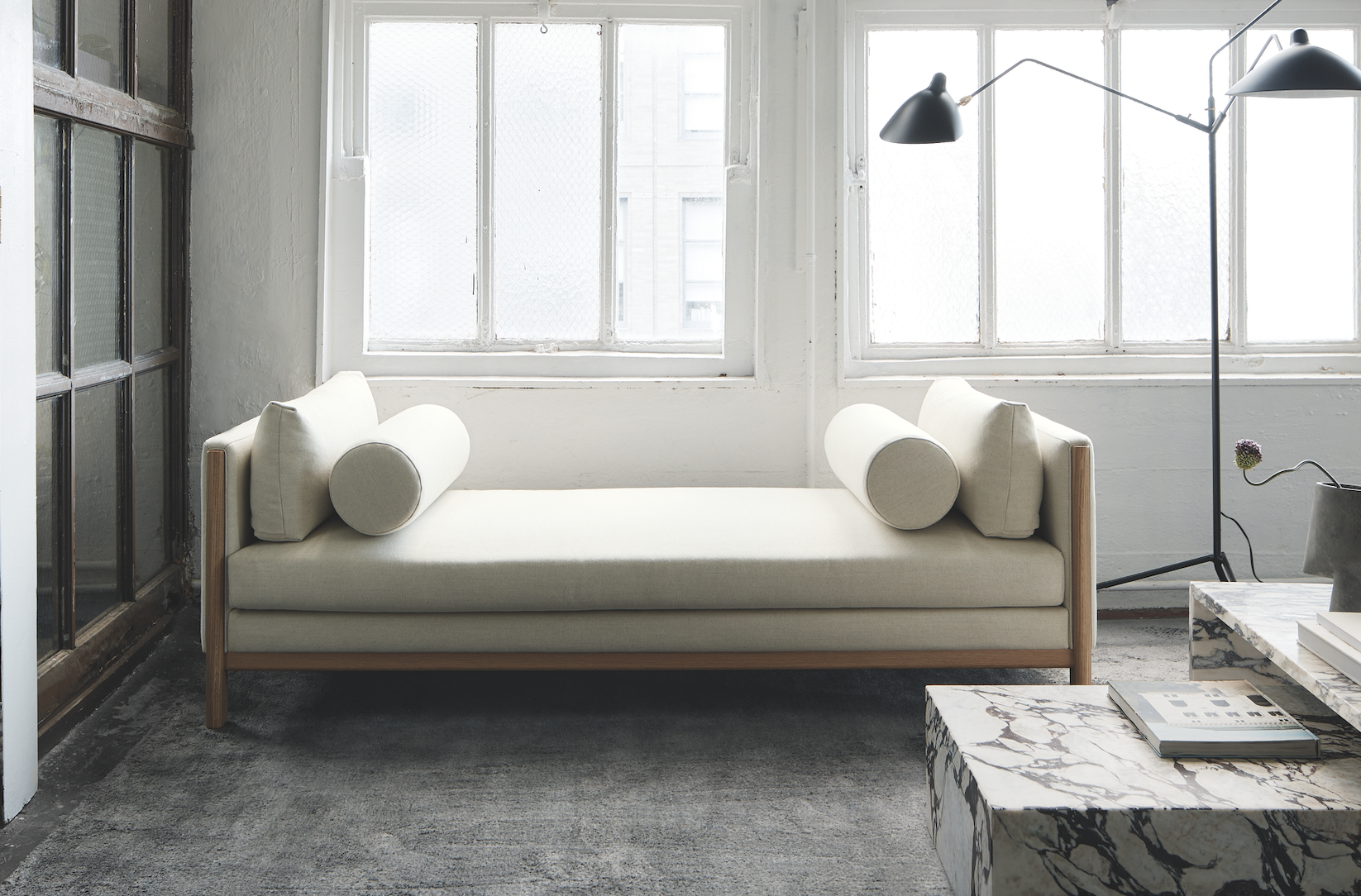
Emmy, Egg Collective
In designing the Emmy chaise, the Egg Collective trio of Stephanie Beamer, Crystal Ellis and Hillary Petrie, who met as students at Washington University in St. Louis, aimed for versatility. Indeed, the tailored chaise looks equally at home in a glass skyscraper as it does in a turn-of-the-century town house. Combining the elegance of a smooth, solid oak or walnut frame with the comfort of bolsters and cushioned upholstery or leather, it works just as well against a wall or at the heart of a room. From around $7,015; Eggcollective.com
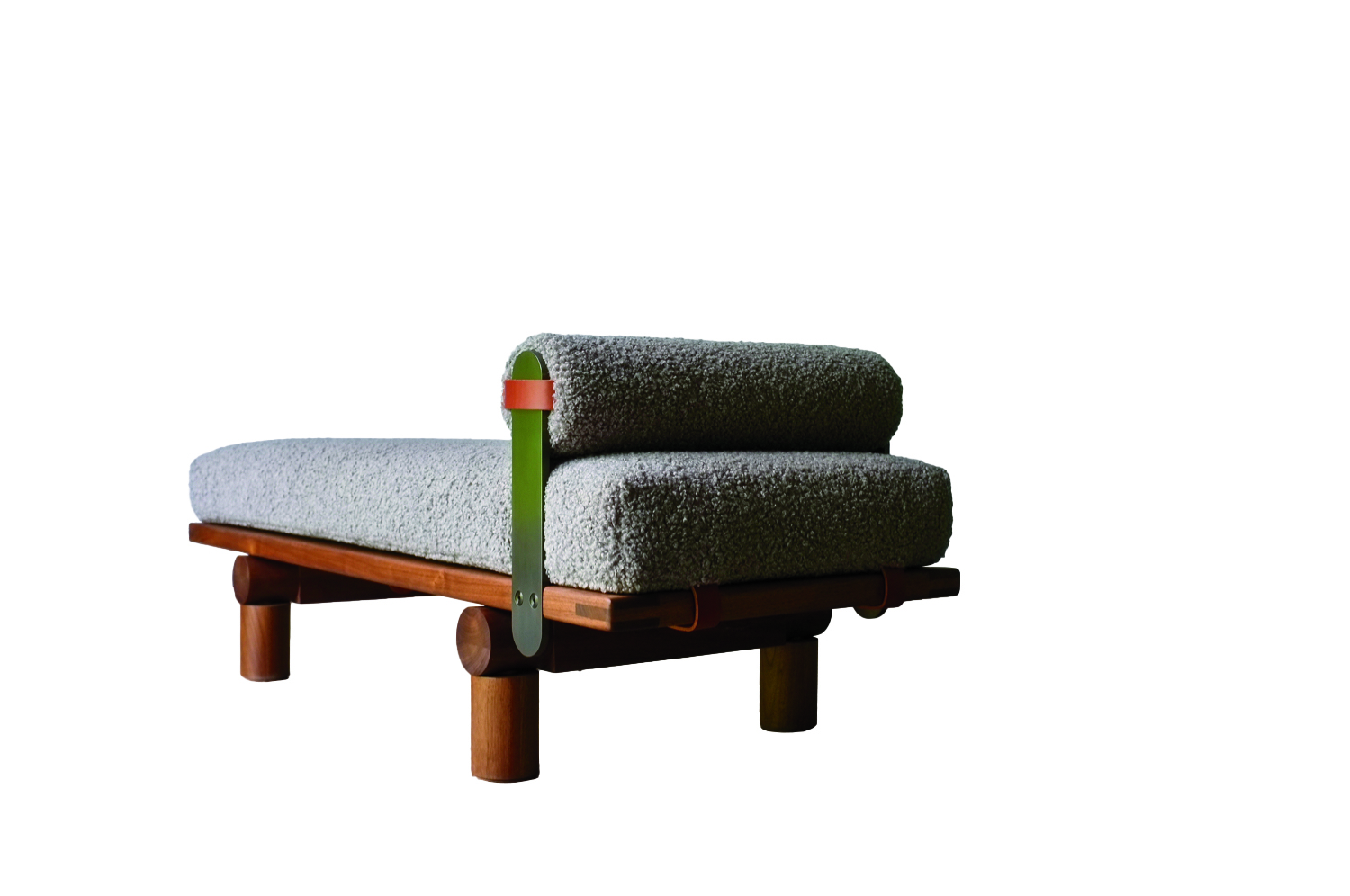 Plum, Michael Robbins
Plum, Michael Robbins
Woodworker Michael Robbins is the quintessential artisan from New York State’s Hudson Valley in that both his materials and methods pay homage to the area. In fact, he describes his style as “honest, playful, elegant and reflective of the aesthetic of the Hudson Valley surroundings”. Robbins crafts his furniture by hand but allows the wood he uses to help guide the look of a piece. (The studio offers eight standard finishes.) The Plum daybed, brought to life at Robbins’s workshop, exhibits his signature modern rusticity injected with a hint of whimsy thanks to the simplicity of its geometric forms. Around $4,275; MichaelRobbins.com
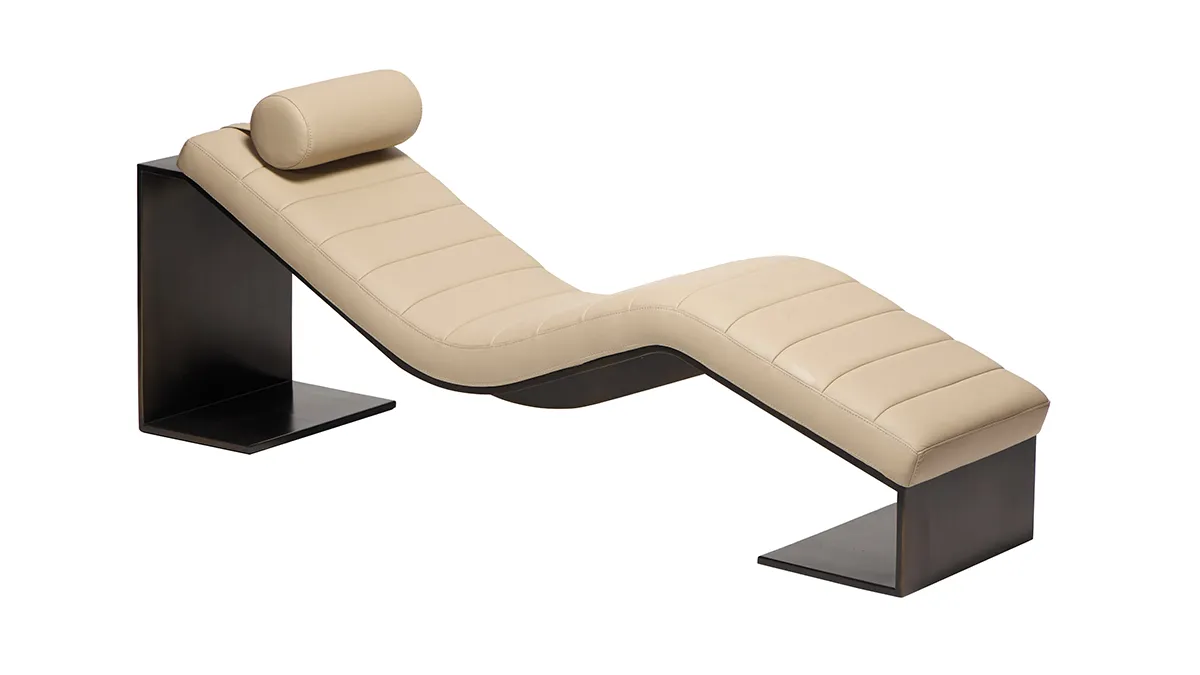
Kimani, Reda Amalou Design
French architect and designer Reda Amalou acknowledges the challenge of creating standout seating given the number of iconic 20th-century examples already in existence. Still, he persists—and prevails. The Kimani, a bent slash of a daybed in a limited edition of eight pieces, makes a forceful statement. Its leather cushion features a rolled headrest and rhythmic channel stitching reminiscent of that found on the seats of ’70s cars; visually, these elements anchor the slender silhouette atop a patinated bronze base with a sure-handed single line. The result: a seamless contour for the body. Around $33,530; RedaAmalou
Dune, Workshop/APD
From a firm known for crafting subtle but luxurious architecture and interiors, Workshop/APD’s debut furniture collection is on point. Among its offerings is the leather-wrapped Dune daybed. With classical and Art Deco influences, its cylindrical bolsters are a tactile celebration, and the peek of the curved satin-brass base makes for a sensual surprise. Associate principal Andrew Kline notes that the daybed adeptly bridges two seating areas in a roomy living space or can sit, bench-style, at the foot of a bed. From $13,040; Workshop/ APD
Sherazade, Edra
Designed by Francesco Binfaré, this sculptural, minimalist daybed—inspired by the rugs used by Eastern civilizations—allows for complete relaxation. Strength combined with comfort is the name of the game here. The Sherazade’s structure is made from light but sturdy honeycomb wood, while next-gen Gellyfoam and synthetic wadding aid repose. True to Edra’s amorphous design codes, it can switch configurations depending on the user’s mood or needs; for example, the accompanying extra pillows—one rectangular and one cylinder shaped— interchange to become armrests or backrests. From $32,900; Edra
You may also like.
By Josh Bozin
24/07/2024
22/07/2024
Watches & Wonders 2024 Showcase: Hermès
We head to Geneva for the Watches & Wonders exhibition; a week-long horological blockbuster featuring the hottest new drops, and no shortage of hype.
With Watches & Wonders 2024 well and truly behind us, we review some of the novelties Hermès presented at this year’s event.
—
HERMÈS
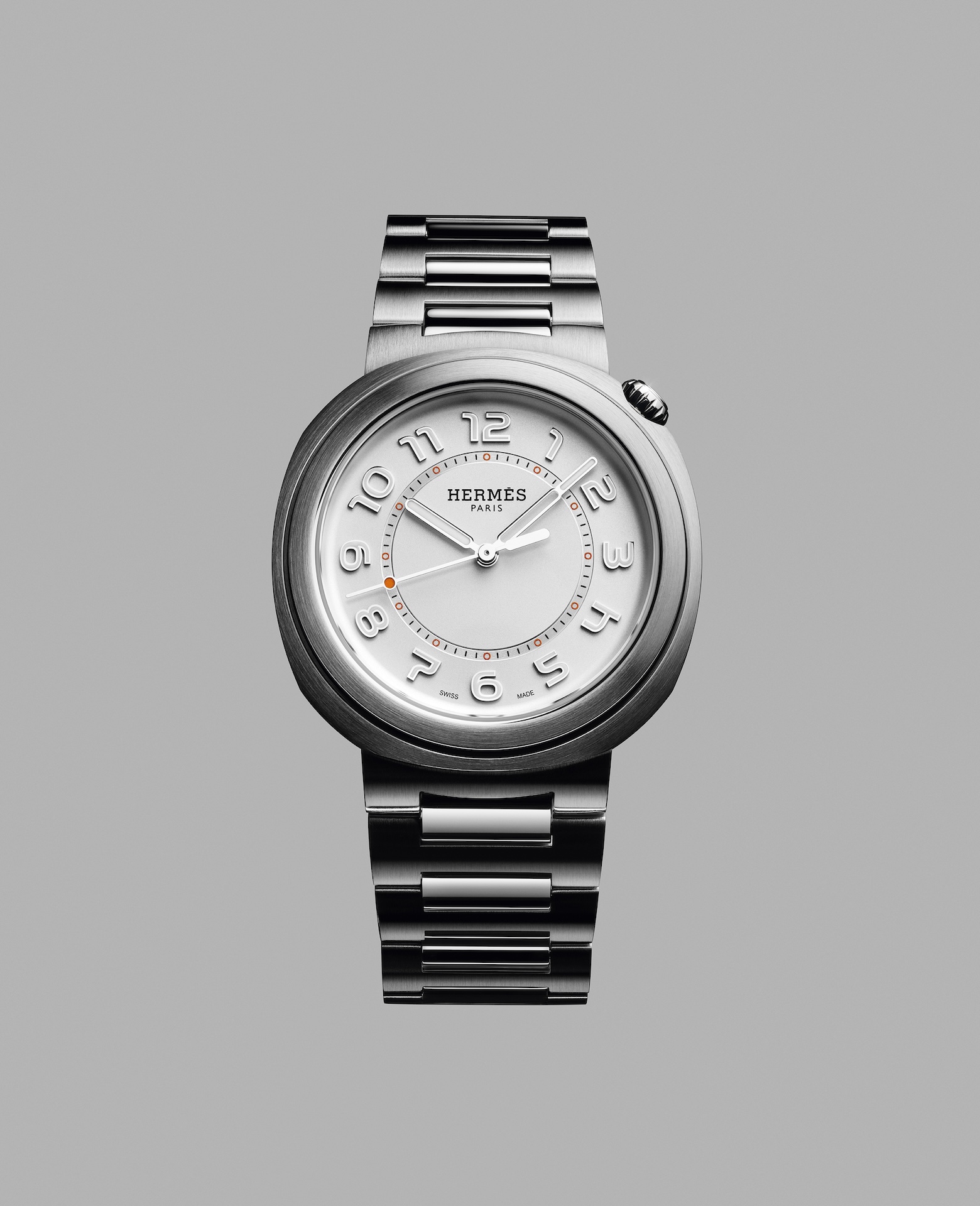
Moving away from the block colours and sporty aesthetic that has defined Hermès watches in recent years, the biggest news from the French luxury goods company at Watches & Wonders came with the unveiling of its newest collection, the Hermès Cut.
It flaunts a round bezel, but the case middle is nearer to a tonneau shape—a relatively simple design that, despite attracting flak from some watch aficionados, works. While marketed as a “women’s watch”, the Cut has universal appeal thanks to its elegant package and proportions. It moves away from the Maison’s penchant for a style-first product; it’s a watch that tells the time, not a fashion accessory with the ability to tell the time.
Hermès gets the proportions just right thanks to a satin-brushed and polished 36 mm case, PVD-treated Arabic numerals, and clean-cut edges that further accentuate its character. One of the key design elements is the positioning of the crown, boldly sitting at half-past one and embellished with a lacquered or engraved “H”, clearly stamping its originality. The watch is powered by a Hermès Manufacture movement H1912, revealed through its sapphire crystal caseback. In addition to its seamlessly integrated and easy-wearing metal bracelet, the Cut also comes with the option for a range of coloured rubber straps. Together with its clever interchangeable system, it’s a cinch to swap out its look.
It will be interesting to see how the Hermès Cut fares in coming months, particularly as it tries to establish its own identity separate from the more aggressive, but widely popular, Ho8 collection. Either way, the company is now a serious part of the dialogue around the concept of time.
—
Read more about this year’s Watches & Wonders exhibition at robbreport.com.au
You may also like.
22/07/2024
Living La Vida Lagerfeld
The world remembers him for fashion. But as a new tome reveals, the iconoclastic designer is defined as much by extravagant, often fantastical, homes as he is clothes.
“Lives, like novels, are made up of chapters”, the world-renowned bibliophile, Karl Lagerfeld, once observed.
Were a psychological-style novel ever to be written about Karl Lagerfeld’s life, it would no doubt give less narrative weight to the story of his reinvigoration of staid fashion houses like Chloe, Fendi and Chanel than to the underpinning leitmotif of the designer’s constant reinvention of himself.
In a lifetime spanning two centuries, Lagerfeld made and dropped an ever-changing parade of close friends, muses, collaborators and ambiguous lovers, as easily as he changed his clothes, his furniture… even his body. Each chapter of this book would be set against the backdrop of one of his series of apartments, houses and villas, whose often wildly divergent but always ultra-luxurious décor reflected the ever-evolving personas of this compulsively public but ultimately enigmatic man.
With the publication of Karl Lagerfeld: A Life in Houses these wildly disparate but always exquisite interiors are presented for the first time together as a chronological body of work. The book indeed serves as a kind of visual novel, documenting the domestic dreamscapes in which the iconic designer played out his many lives, while also making a strong case that Lagerfeld’s impact on contemporary interior design is just as important, if not more so, than his influence on fashion.
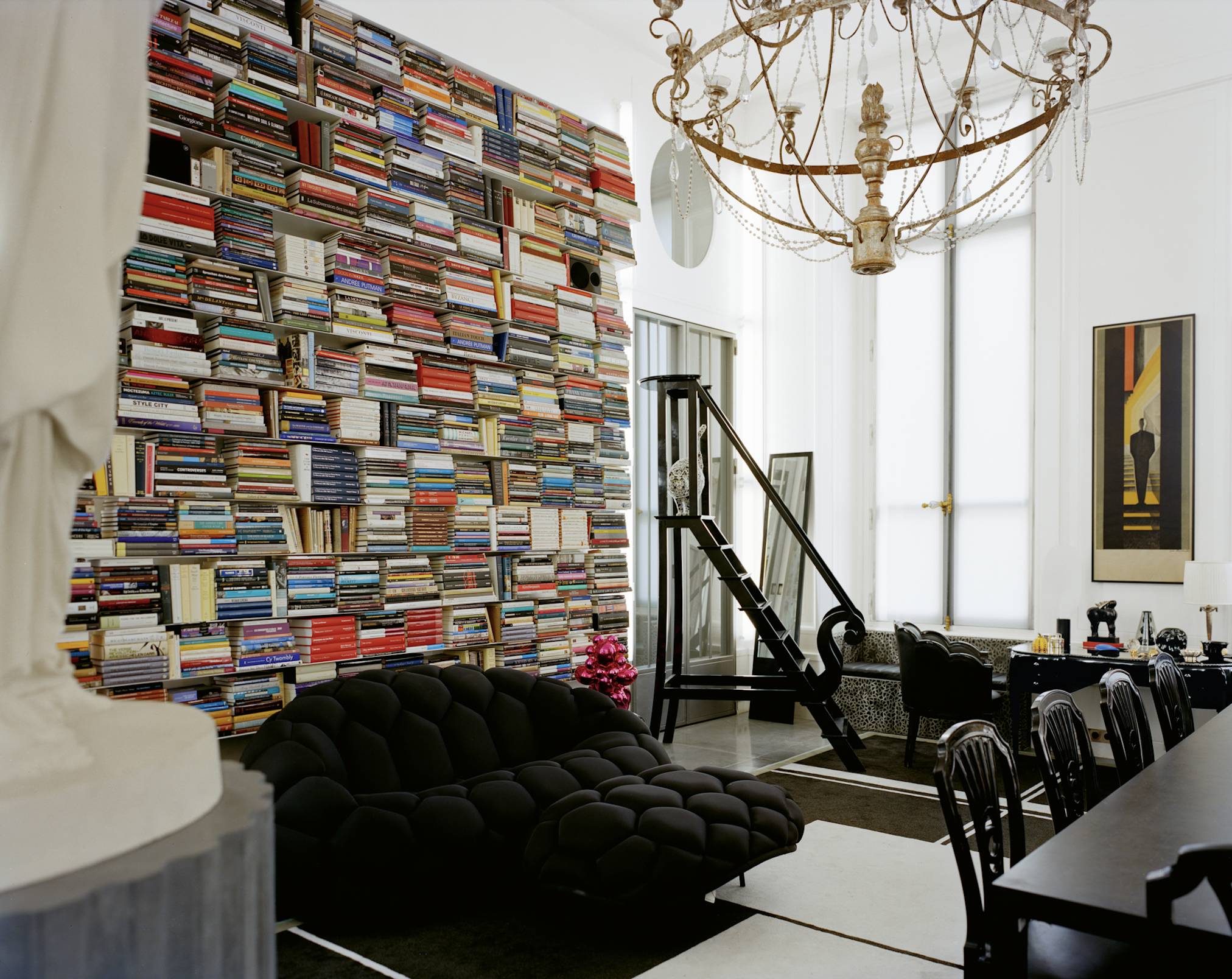
In fact, when the first Lagerfeld interior was featured in a 1968 spread for L’OEil magazine, the editorial describes him merely as a “stylist”. The photographs of the apartment in an 18th-century mansion on rue de Université, show walls lined with plum-coloured rice paper, or lacquered deepest chocolate brown in sharp contrast to crisp, white low ceilings that accentuated the horizontality that was fashionable among the extremely fashionable at the time. Yet amid this setting of aggressively au courant modernism, the anachronistic pops of Art Nouveau and Art Deco objects foreshadow the young Karl’s innate gift for creating strikingly original environments whose harmony is achieved through the deft interplay of contrasting styles and contexts.
Lagerfeld learned early on that presenting himself in a succession of gem-like domestic settings was good for crafting his image. But Lagerfeld’s houses not only provided him with publicity, they also gave him an excuse to indulge in his greatest passion. Shopping!
By 1973, Lagerfeld was living in a new apartment at Place Saint–Sulpice where his acquisition of important Art Deco treasures continued unabated. Now a bearded and muscular disco dandy, he could most often be found in the louche company of the models, starlets and assorted hedonistic beauties that gathered around the flamboyant fashion illustrator Antonio Lopez. Lagerfeld was also in the throes of a hopeless love affair with Jacques de Bascher whose favours he reluctantly shared with his nemesis Yves Saint Laurent.
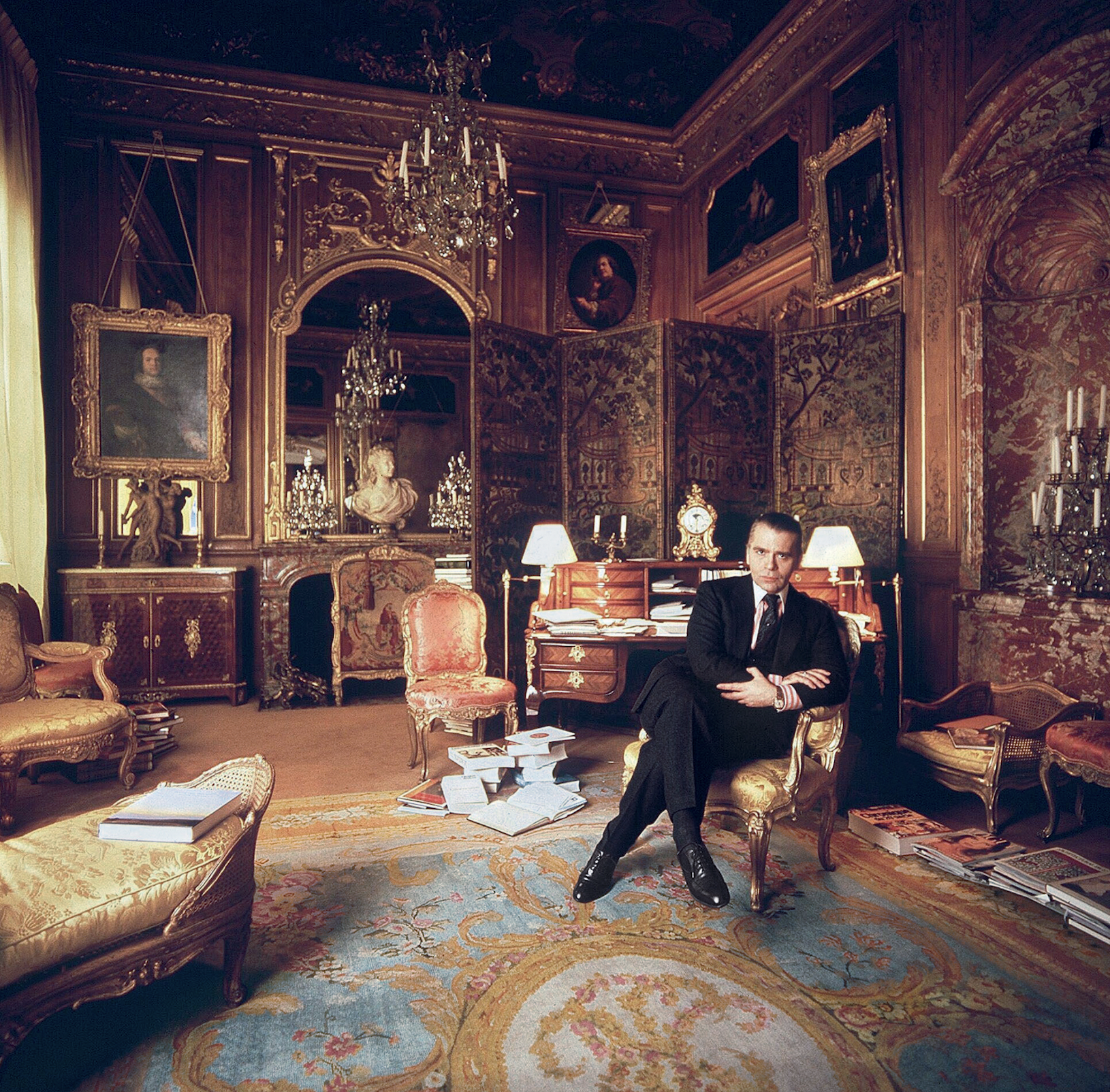
He painted the rooms milky white and lined them with specially commissioned carpets—the tawny patterned striations of which invoked musky wild animal pelts. These lent a stark relief to the sleek, machine-age chrome lines of his Deco furnishings. To contemporary eyes it remains a strikingly original arrangement that subtly conveys the tensions at play in Lagerfeld’s own life: the cocaine fuelled orgies of his lover and friends, hosted in the pristine home of a man who claimed that “a bed is for one person”.
In 1975, a painful falling out with his beloved Jacques, who was descending into the abyss of addiction, saw almost his entire collection of peerless Art Deco furniture, paintings and objects put under the auctioneer’s hammer. This was the first of many auction sales, as he habitually shed the contents of his houses along with whatever incarnation of himself had lived there. Lagerfeld was dispassionate about parting with these precious goods. “It’s collecting that’s fun, not owning,” he said. And the reality for a collector on such a Renaissance scale, is that to continue buying, Lagerfeld had to sell.
Of all his residences, it was the 1977 purchase of Hôtel Pozzo di Borgo, a grand and beautifully preserved 18th-century house, that would finally allow him to fulfill his childhood fantasies of life in the court of Madame de Pompadour. And it was in this aura of Rococó splendour that the fashion designer began to affect, along with his tailored three-piece suits, a courtier’s ponytailed and powdered coif and a coquettish antique fan: marking the beginning of his transformation into a living, breathing global brand that even those with little interest in fashion would immediately recognise.
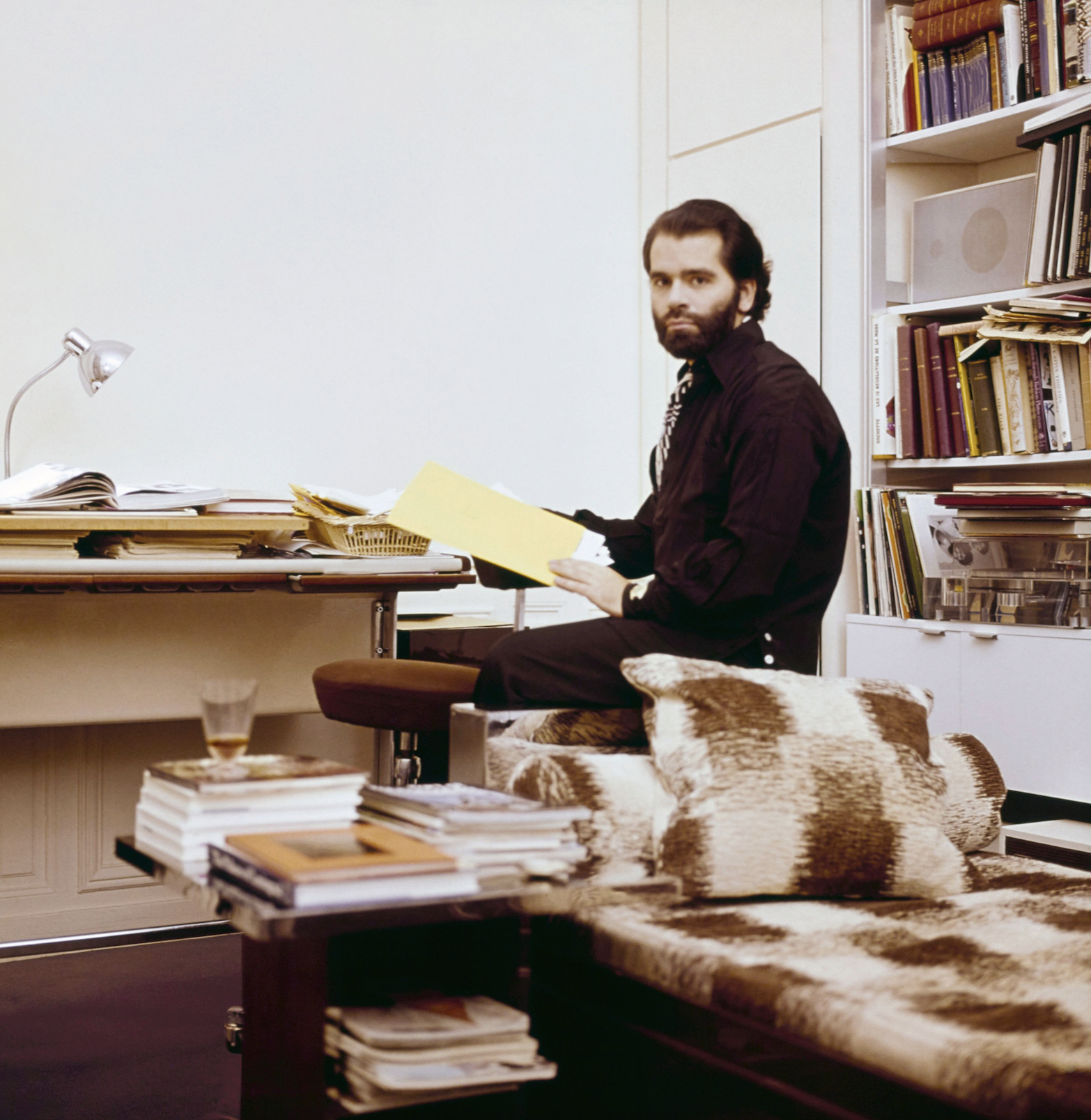
Lagerfeld’s increasing fame and financial success allowed him to indulge in an unprecedented spending frenzy, competing with deep-pocketed institutions like the Louvre to acquire the finest, most pedigreed pearls of the era—voluptuously carved and gilded bergères; ormolu chests; and fleshy, pastel-tinged Fragonard idylls—to adorn his urban palace. His one-time friend André Leon Talley described him in a contemporary article as suffering from “Versailles complex”.
However, in mid-1981, and in response to the election of left-wing president, François Mitterrand, Lagerfeld, with the assistance of his close friend Princess Caroline, became a resident of the tax haven of Monaco. He purchased two apartments on the 21st floor of Le Roccabella, a luxury residential block designed by Gio Ponti. One, in which he kept Jacques de Bascher, with whom he was now reconciled, was decorated in the strict, monochromatic Viennese Secessionist style that had long underpinned his aesthetic vocabulary; the other space, though, was something else entirely, cementing his notoriety as an iconoclastic tastemaker.
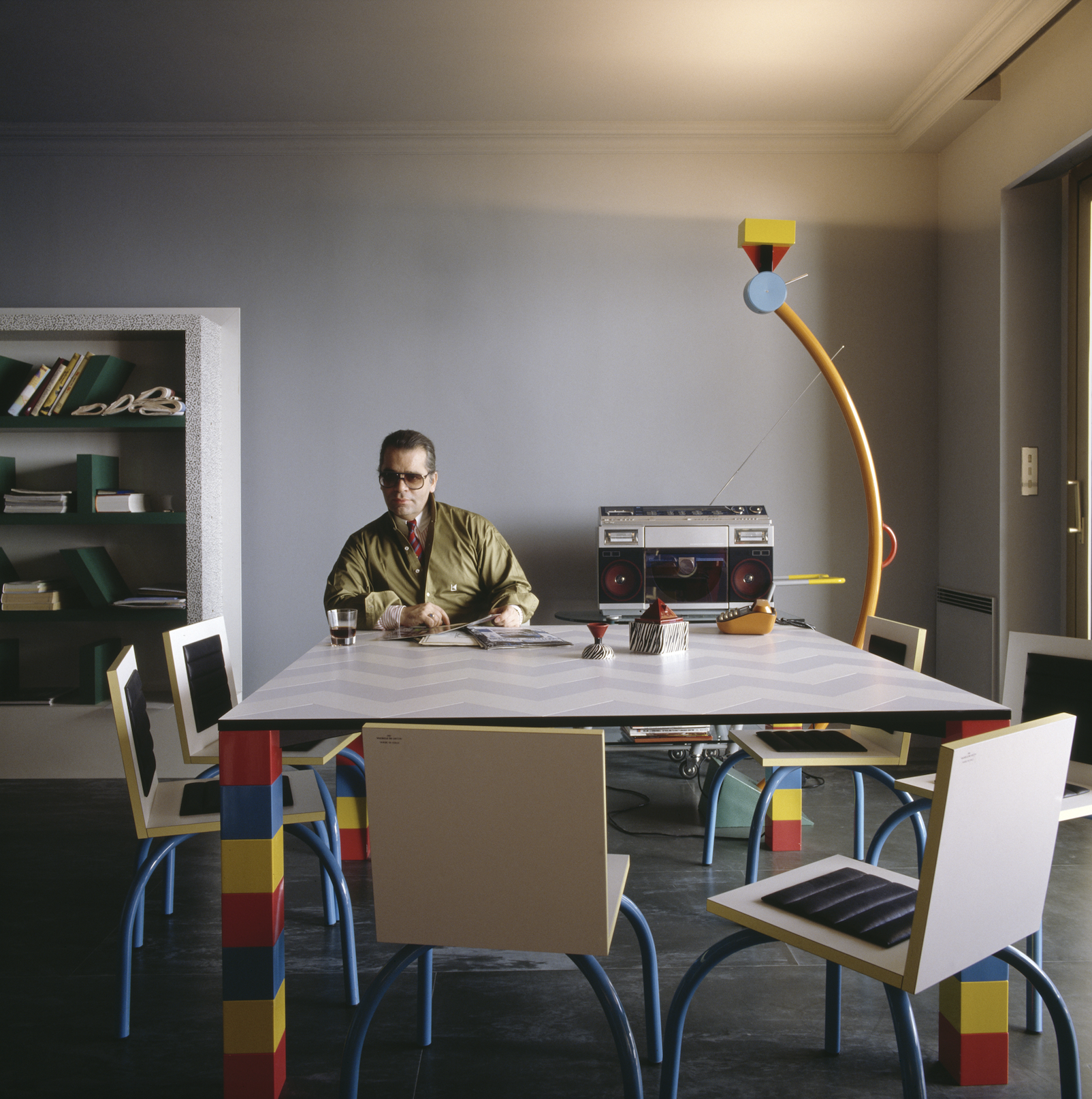
Lagerfeld had recently discovered the radically quirky designs of the Memphis Group led by Ettore Sottsass, and bought the collective’s entire first collection and had it shipped to Monaco. In a space with no right angles, these chaotically colourful, geometrically askew pieces—centred on Masanori Umeda’s famous boxing ring—gave visitors the disorientating sensation of having entered a corporeal comic strip. By 1991, the novelty of this jarring postmodern playhouse had inevitably worn thin and once again he sent it all to auction, later telling a journalist that “after a few years it was like living in an old Courrèges. Ha!”

In 1989, de Bascher died of an AIDS-related illness, and while Lagerfeld’s career continued to flourish, emotionally the famously stoic designer was struggling. In 2000, a somewhat corpulent Lagerfeld officially ended his “let them eat cake” years at the Hôtel Pozzo di Borgo, selling its sumptuous antique fittings in a massive headline auction that stretched over three days. As always there were other houses, but now with his longtime companion dead, and his celebrity metastasising making him a target for the paparazzi, he began to look less for exhibition spaces and more for private sanctuaries where he could pursue his endless, often lonely, work.
His next significant house was Villa Jako, named for his lost companion and built in the 1920s in a nouveau riche area of Hamburg close to where he grew up. Lagerfeld shot the advertising campaign for Lagerfeld Jako there—a fragrance created in memorial to de Bascher. The house featured a collection of mainly Scandinavian antiques, marking the aesthetic cusp between Art Nouveau and Art Deco. One of its rooms Lagerfeld decorated based on his remembrances of his childhood nursery. Here, he locked himself away to work—tellingly—on a series of illustrations for the fairy tale, The Emperor’s New Clothes. Villa Jako was a house of deep nostalgia and mourning.
But there were more acts—and more houses—to come in Lagerfeld’s life yet. In November 2000, upon seeing the attenuated tailoring of Hedi Slimane, then head of menswear at Christian Dior, the 135 kg Lagerfeld embarked on a strict dietary regime. Over the next 13 months, he melted into a shadow of his former self. It is this incarnation of Lagerfeld—high white starched collars; Slimane’s skintight suits, and fingerless leather gloves revealing hands bedecked with heavy silver rings—that is immediately recognisable some five years after his death.
The 200-year-old apartment in Quái Voltaire, Paris, was purchased in 2006, and after years of slumber Lagerfeld—a newly awakened Hip Van Winkle—was ready to remake it into his last modernist masterpiece. He designed a unique daylight simulation system that meant the monochromatic space was completely without shadows—and without memory. The walls were frosted and smoked glass, the floors concrete and silicone; and any hint of texture was banned with only shiny, sleek pieces by Marc Newson, Martin Szekely and the Bouroullec Brothers permitted. Few guests were allowed into this monastic environment where Lagerfeld worked, drank endless cans of Diet Coke and communed with Choupette, his beloved Birman cat, and parts of his collection of 300,000 books—one of the largest private collections in the world.
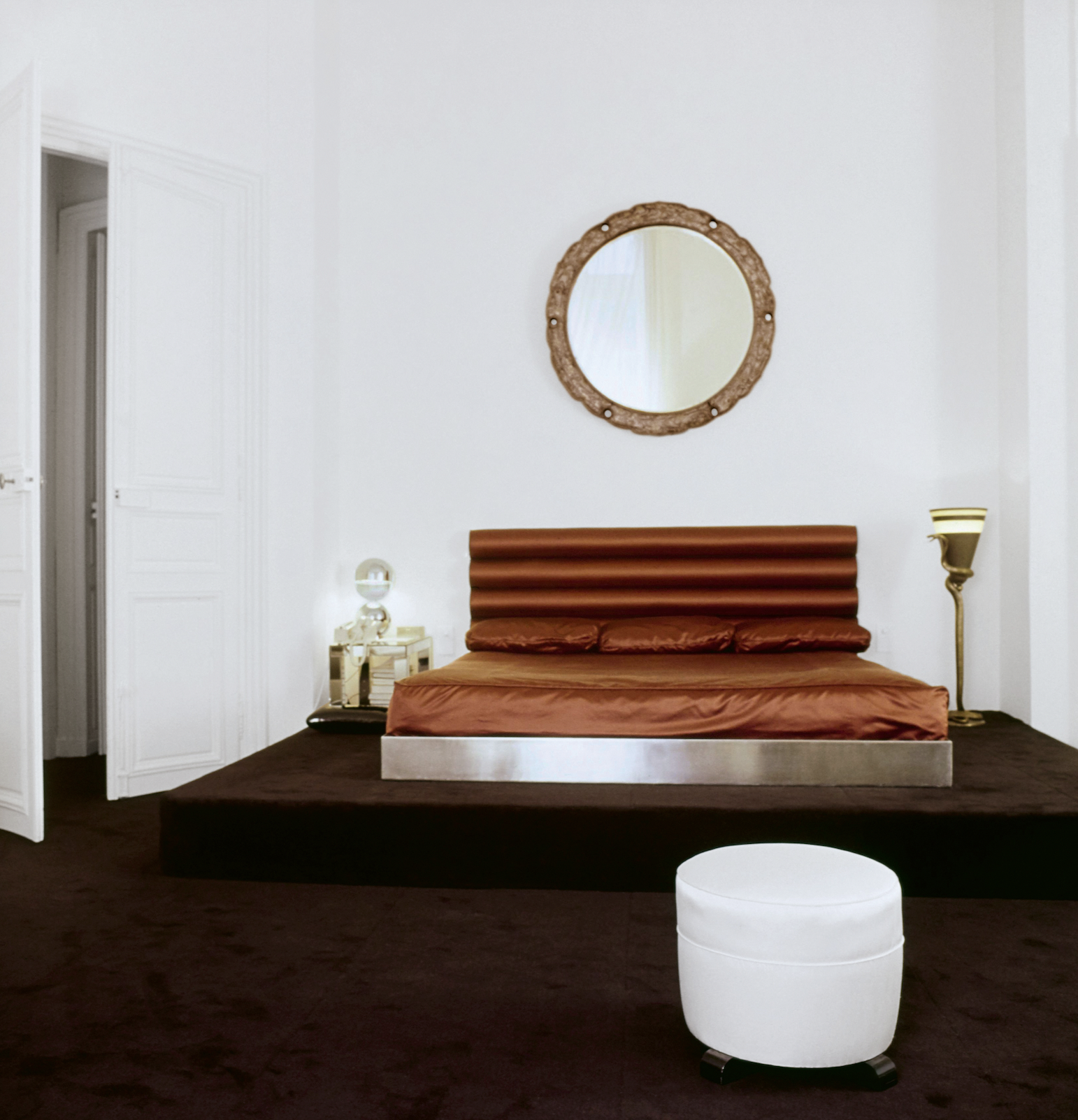
Lagerfeld died in 2019, and the process of dispersing his worldly goods is still ongoing. The Quái Voltaire apartment was sold this year for US$10.8 million (around $16.3 million). Now only the rue de Saint-Peres property remains within the Lagerfeld trust. Purchased after Quái Voltaire to further accommodate more of his books—35,000 were displayed in his studio alone, always stacked horizontally so he could read the titles without straining his neck—and as a place for food preparation as he loathed his primary living space having any trace of cooking smells. Today, the rue de Saint-Peres residence is open to the public as an arts performance space and most fittingly, a library.
You may also like.
By Josh Bozin
24/07/2024
Watch This Space: Mike Nouveau
Meet the game-changing horological influencers blazing a trail across social media—and doing things their own way.
In the thriving world of luxury watches, few people own a space that offers unfiltered digital amplification. And that’s precisely what makes the likes of Brynn Wallner, Teddy Baldassarre, Mike Nouveau and Justin Hast so compelling.
These thought-provoking digital crusaders are now paving the way for the story of watches to be told, and shown, in a new light. Speaking to thousands of followers on the daily—mainly via TikTok, Instagram and YouTube—these progressive commentators represent the new guard of watch pundits. And they’re swaying the opinions, and dollars, of the up-and-coming generations who now represent the target consumer of this booming sector.
—
MIKE NOUVEAU
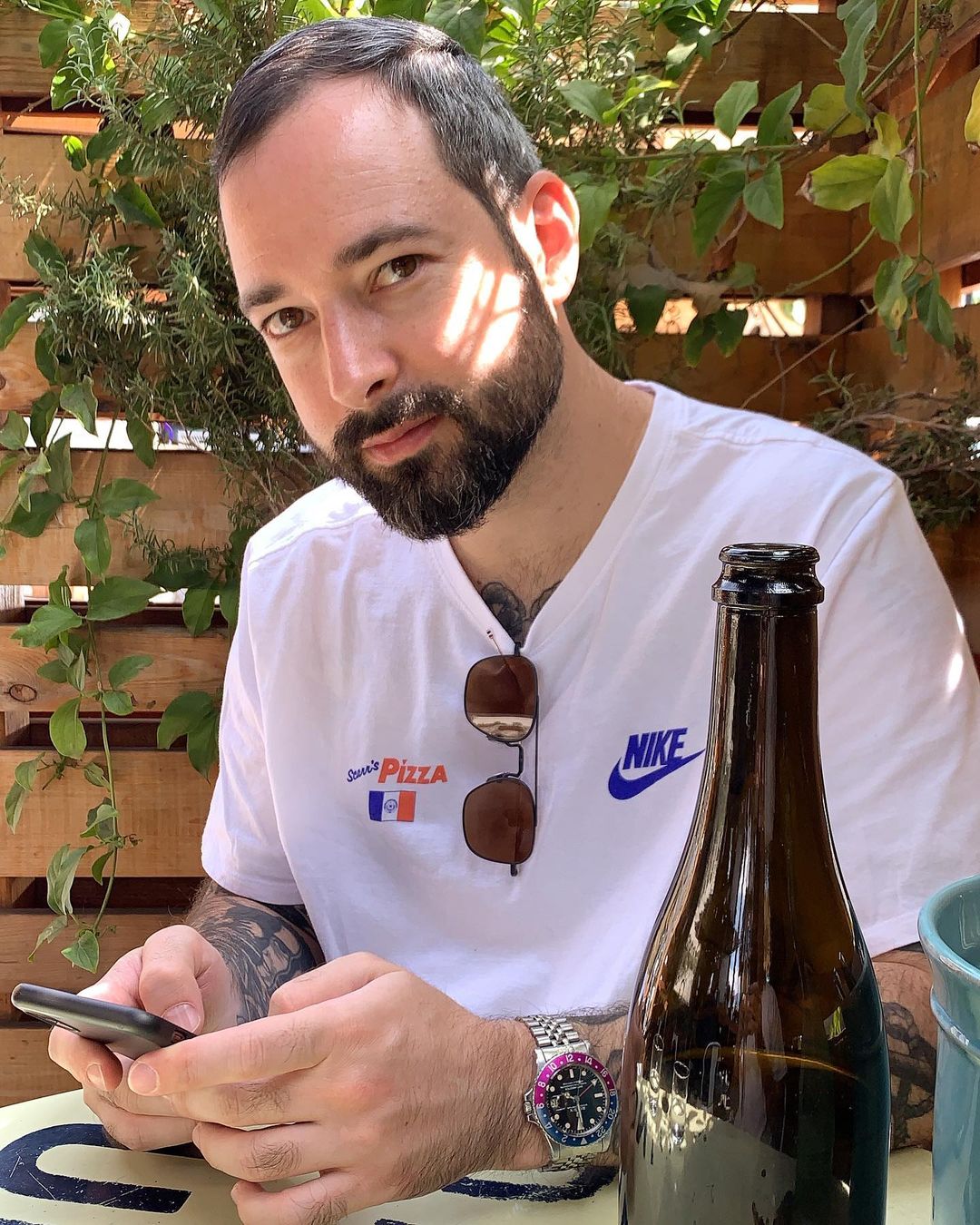
Can we please see what’s on the wrist? That’s the question that catapulted Mike Nouveau into watch stardom, thanks to his penchant for highlighting incredibly rare timepieces across his TikTok account of more than 400,000 followers. When viewing Nouveau’s attention-grabbing video clips—usually shot in a New York City neighbourhood—it’s not uncommon to find him wrist-rolling some of the world’s rarest timepieces, like the million-dollar Cartier Cheich (a clip he posted in May).
But how did someone without any previous watch experience come to amass such a cult following, and in the process gain access to some of the world’s most coveted timepieces? Nouveau admits had been a collector for many years, but moved didn’t move into horology full-time until 2020, when he swapped his DJing career for one as a vintage watch specialist.
“I probably researched for a year before I even bought my first watch,” says Nouveau, alluding to his Rolex GMT Master “Pepsi” ref. 1675 from 1967, a lionised timepiece in the vintage cosmos. “I would see deals arise that I knew were very good, but they weren’t necessarily watches that I wanted to buy myself. I eventually started buying and selling, flipping just for fun because I knew how to spot a good deal.”
Nouveau claims that before launching his TikTok account in the wake of Covid-19, no one in the watch community knew he existed. “There really wasn’t much watch content, if any, on TikTok before I started posting, especially talking about vintage watches. There’s still not that many voices for vintage watches, period,” says Nouveau. “It just so happens that my audience probably skews younger, and I’d say there are just as many young people interested in vintage watches as there are in modern watches.”
View this post on Instagram
Nouveau recently posted a video to his TikTok account revealing that the average price of a watch purchased by Gen Z is now almost US$11,000 (around $16,500), with 41 percent of them coming into possession of a luxury watch in the past 12 months.
“Do as much independent research as you can [when buying],” he advises. “The more you do, the more informed you are and the less likely you are to make a mistake. And don’t bring modern watch expectations to the vintage world because it’s very different. People say, ‘buy the dealer’, but I don’t do that. I trust myself and myself only.”
—
Read more about the influencers shaking up horology here with Justin Hast, Brynn Wallner and Teddy Baldassare.
You may also like.
By Josh Bozin
24/07/2024
This Pristine 1960 Ferrari 250 Spider Could Fetch $24 Million at Auction
The car wears the same colours and has the same engine it left the factory with.
Some Ferraris are just a little bit more important than others.
Take, for example, the 1960 250 GT SWB California that RM Sotheby’s is auctioning off during this year’s Monterey Car Week. Any example of the open-top beauty would attract interest, but this one just so happens to be the first one that was built.
The 250 is one of the most legendary series of cars in Ferrari history. Between 1952 and 1964, the company released 21 different 250 models—seven for racetracks, 14 for public roads—of which the “Cali Spider” might be the most well regarded, thanks to its potent V-12 and a Pininfarina-penned design that is one of the most beautiful bodies to grace an automobile. The roadster, which was specifically built for the U.S., made its debut in 1957 as a long-wheel-base model (LWB), but it wasn’t until the SWB model debut in 1960 that it became clear how special it was. This example isn’t just the first to roll off the line. It’s the actual car that was used to introduce the world to the model at the 1960 Geneva Motor Show.
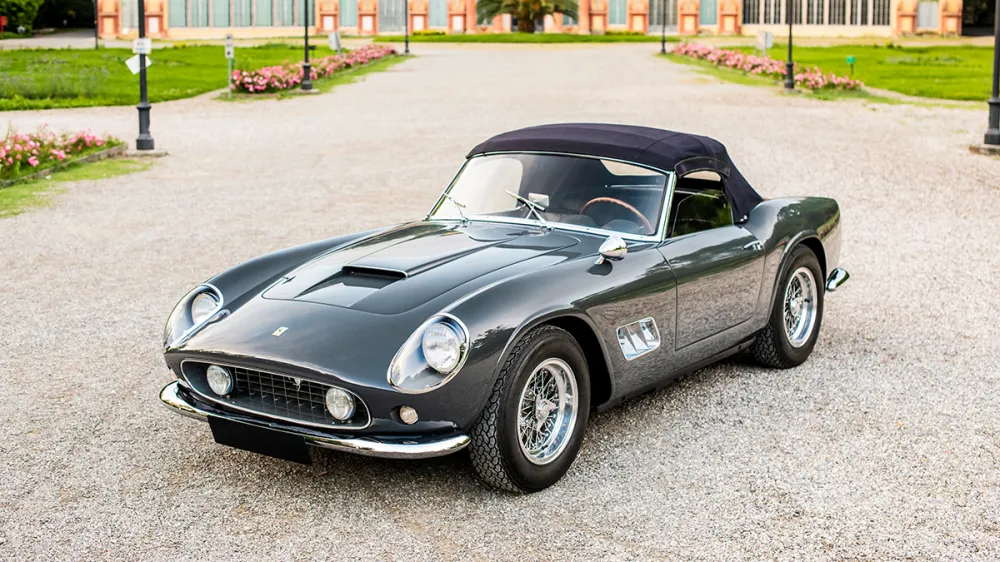
Just 56 examples of the 250 GT SWB California Spider would be built by Scaglietti during the three years it was in production. The first of those, chassis 1795 GT, is finished in a glossy coat of Grigio. The two-door had a red leather interior at Geneva but was returned to the factory and re-outfitted with black leather upholstery before being delivered to its original owner, British race car driver John Gordon Bennet. Six-and-a-half decades later the car looks identical to how it did when it left the factory the second time.
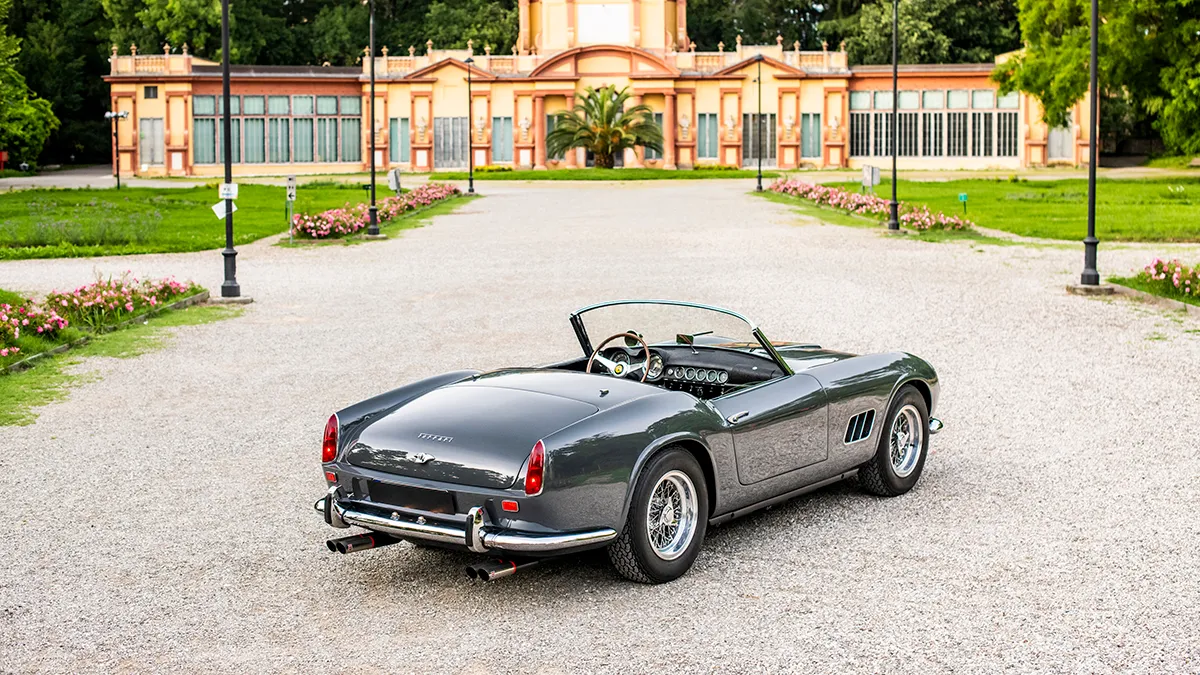
In addition to its original bodywork, the chassis 1795 GT features its original engine, gearbox, and rear axle. That mill is the competition-spec Tipo 168, a 3.0-litre V-12 that makes 196.1 kW. That may not sound like much by today’s standards, but, when you consider that the 250 GT SWB California Spider tips the scales around 952 kilograms, it’s more than enough.
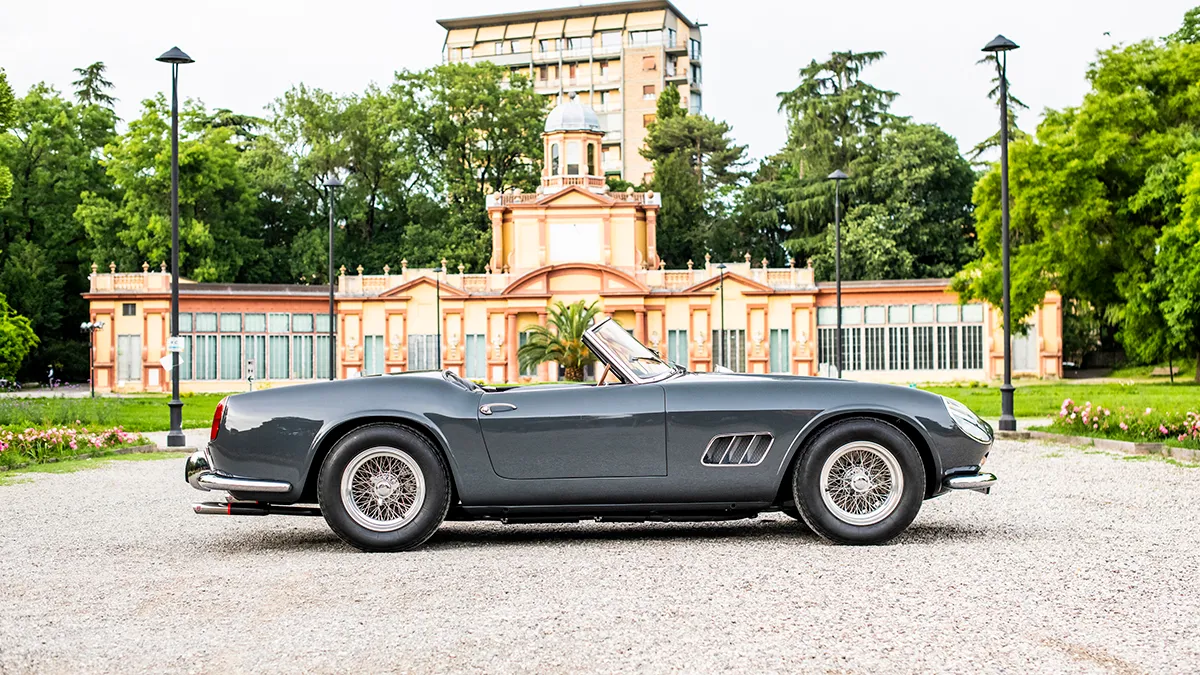
The first 250 GT SWB California Spider is scheduled to go up for bid during RM Sotheby’s annual Monterey Car Week auction, which runs from Thursday, August 15, to Saturday, August 17. Unsurprisingly, the house has quite high hopes for the car. The car carries an estimate of between $24 million and $26 million, which could make it one of the most expensive cars ever sold at auction.
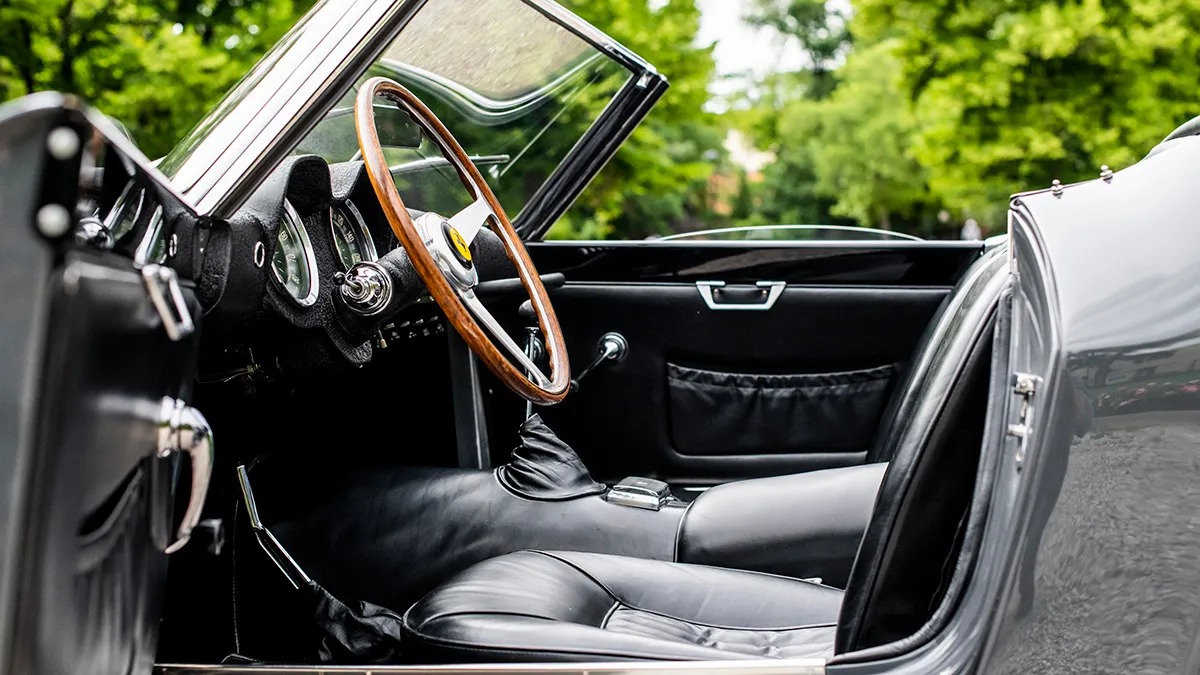
You may also like.
By Josh Bozin
24/07/2024






